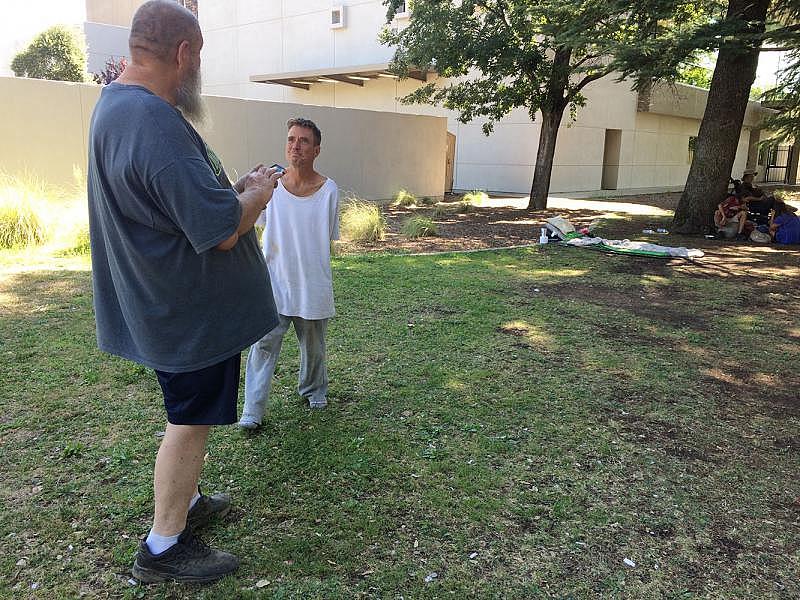Oppressed By Wildfire: Homeless People Left Out Of Federal Disaster Aid Programs
This story was produced as a project for the 2019 California Fellowship, a program of USC Annenberg's Center for Health Journalism.
Other stories in this series include:
Oppressed By Wildfire: Language Barriers, Unwelcoming Attitudes Discourage Latinos From Seeking Help
Oppressed By Wildfire: Disabilities Challenge Some Victims' Evacuations And Their Recovery
Oppressed By Wildfire: Weaving Culture Into Fire Management Helps Tribes Reclaim Suppressed Heritage

APRIL EHRLICH | JPR NEWS
When a major wildfire burns into an urban area, federal disaster officials are quick to offer financial help to people who lose their homes. But not everyone is eligible for aid after a wildfire.
In fact, if you don’t have a home address, there’s a good chance you can’t even get into a shelter.
It turns out the Federal Emergency Management Administration doesn’t provide disaster aid to people who were homeless prior to a disaster.
“Unless people are made homeless by a declared disaster, assistance for pre-disaster homelessness does not fall within the rules, policies, and guidance for eligibility to receive Stafford Act assistance,” a FEMA spokesperson wrote in an email to JPR.
The Stafford Act is a federal law outlining how federal natural disaster aid can be spent.
Since they couldn't go to a shelter, houseless people in Redding had few options for escaping unhealthy air and triple digit heat during the Carr Fire, which killed eight people and destroyed hundreds of homes in 2018.
Scott Smith says he found respite in the shade of a small park near the Redding Public Library.
“It was really smoky. It was bad,” Smith says. “We just stayed buckled down in the park. We couldn’t do much of anything except sit in the park and make it through the smoke.”
George Felix was also at the park after the fire hit. He lives in a beat-up trailer in the woods outside town, but he considers himself homeless. He was once a firefighter until heart problems forced him to retire early, so he affords what he can with his disability checks, including food for his friends at the Redding library park.
Felix says a few days after the fire hit, evacuation shelters and other agencies would bring leftover food to the park.
“They had extra so they’d come down and feed us,” Felix says. “The cops left us alone for a few days. Where do we go? Then they pulled a 10-car raid with dogs. Cops everywhere.”
Redding Police Chief Bill Schueller says he’s not sure if police raided the park a week after the fire, but that his team does do sweeps of public spaces when people are there past curfew.
“So it is entirely possible that happened,” Schueller says. “I wouldn't doubt it. And it’s a violation. If they're there after the park is closed they can be cited and or arrested. It’s a misdemeanor violation.”
The Good News Rescue Mission is the only overnight shelter in Redding. It’s a religious nonprofit with about 250 beds in different buildings across town.
Many homeless people say they choose not to stay at the Mission because its rules are too strict. For example, those who opt out of its Christian church service still have to remain on the property and sit nearby while that service is going.
“They treat us badly,” Smith says. “You do anything wrong — like you spit on the ground outside — they give you a 30 day notice and you're out. You do any little thing and you’re out. I'd rather be out here because I'm more free and I know how to survive out here.”
Sarah Mickelson is a policy director with the National Low Income Housing Coalition, which takes issue with FEMA's policy of denying disaster aid to people who are homeless.
“FEMA says that its responsibility is really just to bring people up to where they were prior to the disaster,” Mickelson says. “And so that often means that people experiencing homelessness are shut out from FEMA assistance.”
Mickelson says FEMA programs were designed with white, middle class families in mind, and the agency fails to address the needs of people who don’t fall into that category. For instance, FEMA’s transitional shelter program provides motels to people after a disaster. But sometimes there are too few participating hotels, or they’re far from where people work, or disaster victims don’t have a credit card for the hotel’s daily fees.
Mickelson says these barriers to disaster assistance have long-term consequences.
“When people can’t access FEMA assistance, they either return back to uninhabitable homes, which puts them at risk of health or safety issues or they sleep in their cars or in tents or in shelters, they double or triple up with other low income families, or they pay at least half of their income on rent, putting them at higher risk for evictions,” Mickelson says.
As a result, homeless numbers spike after a disaster. The number of people living on the streets in Redding increased by 20 percent after the 2018 wildfire. This trend resulted in homeless advocates calling on local governments to fill the gaps left by FEMA; to do more to help people during disasters, whether they’re living in a beat-up trailer in the woods or at a park under a small bit of shade.
[This article was originally published by Jefferson Public Radio.]

